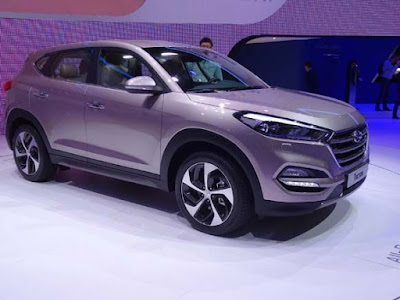The versatile Kia Sportspace Concept bowed in Geneva with contemporary take on a mid-size vehicle intended to "meet the demands of those who refuse to be categorized when it comes to their lifestyle or their motoring needs." Created at Kia's European Design Center in Frankfurt under the direction of Gregory Guillaume, the Sportspace embodies a multifaceted character that has an elevated sense of style in a wagon. Guillaume says the concept would be a welcome addition to the Kia's European lineup, the Sportspace Concept also is believed to offer an early look at some of the cues we may see in the 2016 Kia Optima sedan - a for-sure update that has already been spied testing on the continent
Finished in Ignition Red, the 5-door Sportspace integrates flowing lines and dynamic proportions with more sophisticated detailing at both ends. Kia's signature "tiger-nose" grille has a bolder appearance set off by an articulated and louvered Plexiglass insert that can rotate as needed to increase cooling. The vehicle also sports unique "ice cube" LED headlamps and satin-aluminum strips in the lower apron that keep the directional signals hidden until they're activated. A strong D-pillar treatment, angled hatch, carbon fiber kick plates and 20-inch alloy wheels add interest to the profile while the tail of the Sportspace boasts a tastefully integrated roof spoiler, aggressive carbon fiber diffuser and LED taillamps with sequential turn signals
Inside, the Sportspace's 4-passenger cabin matches contemporary design with impressive practicality setting off supple smooth and hand-woven leather seat coverings with carbon fiber and milled, anodized aluminum trim. The floating dash pairs digital instrumentation with a new infotainment system that features split-screen capability while the conventional inside mirror gives way to a smaller screen that displays images from a rear-mounted camera as well as other pertinent vehicle info. In addition to generous legroom and headroom, the two rear passengers can use special clamps on the front seatbacks to mount two tablet PCs stored in the car's full-length center console. Ever ready to accommodate skis that can be easily slid between its rear seats, the Sportspace also features an array of 28 steel balls in its load floor that allow heavy, bulky cargo to glide into place before retracting when the large liftgate is closed
An advanced 2.0-liter T-GDI (turbocharged gasoline direct injected) 4-cylinder engine provides motivation for the Sportspace Concept and sends its 247 horsepower to the front wheels through an automatic transmission. It's still too early to tell how much of the look and technology in this engaging Kia one-off will actually transfer to the upcoming Optima line -- in sedan or wagon form. But the Sportspace Concept definitely makes a statement we hope is realized in the years ahead

















































